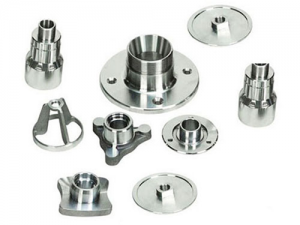Metal 3D printing
Short Description:
Metal 3D printing is a process of forming parts by heating, sintering, melting and cooling of metal powder by laser or electron beam scanning under the control of computer. 3D printing does not need mold, forming fast, high cost, suitable for sample and small batch production.
Metal 3D printing (3DP) is a kind of rapid prototyping technology. It is a technology based on digital model file, which uses powder metal or plastic and other adhesive materials to construct objects by layer printing. The difference between metal 3D printing and plastic 3D printing: These are two technologies. The raw material of metal 3D printing is metal powder, which is produced and printed by laser high temperature sintering. The material used for plastic 3D printing is liquid, which is radiated to the liquid material by ultraviolet rays of different wavelengths, resulting in polymerization reaction and curing.
1. Characteristics of metal 3D printing
1 . advantages of metal 3D printing
A. Rapid prototyping of parts
B. This technology can use thin metal powder materials to produce complex shapes which can not be realized by traditional technology such as casting, forging and processing.
Compared with traditional manufacturing processes, 3D printing has many advantages, including:
A . high overall utilization rate of materials;
B . no need to open the mold, less manufacturing process and short cycle;
C Manufacturing cycle time is short. In particular, 3D printing of parts with complex shapes takes one fifth or even one tenth of the time of ordinary machining
D . parts with complex structure can be manufactured, such as internal conformal flow channel;
E . free design according to the mechanical property requirements without considering the manufacturing process.
Its printing speed is not high, and it is usually used in the rapid manufacturing of single or small batch parts, without the cost and time of mold opening. Although 3D printing is not suitable for mass production, it can be used for rapid manufacturing of various molds for mass production.
2 .disadvantages of metal 3D printing
Metal 3D printing offers new design possibilities, such as integrating multiple components in the production process to minimize material use and mold processing costs.
A) . The deviation of metal 3D printing parts is generally greater than + / -0.10 mm, and the accuracy is not as good as that of ordinary machine tools.
B) The heat treatment property of 3D printing of metal will be deformed: the selling point of 3D printing of metal is mainly high precision and strange shape. If the 3D printing of steel parts is heat treated, the parts will lose precision, or need to be reprocessed by machine tools
Part of the traditional material reduction machining can produce a very thin hardening layer on the surface of the parts. 3D printing is not so good. Moreover, the expansion and contraction of the steel parts are serious in the process of machining. The temperature and gravity of the parts will have a serious impact on the accuracy
2. Materials used for metal 3D printing
It includes stainless steel (AISI316L), aluminum, titanium, Inconel (Ti6Al4V) (625 or 718), and martensitic steel.
1).tool and martensitic steels
2). stainless steel.
3). Alloy: the most widely used metal powder alloy for 3D printing materials are pure titanium and titanium alloy, aluminum alloy, nickel base alloy, cobalt chromium alloy, copper base alloy, etc.
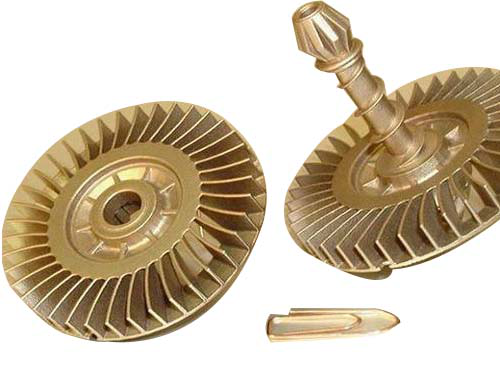
Copper 3D printing parts
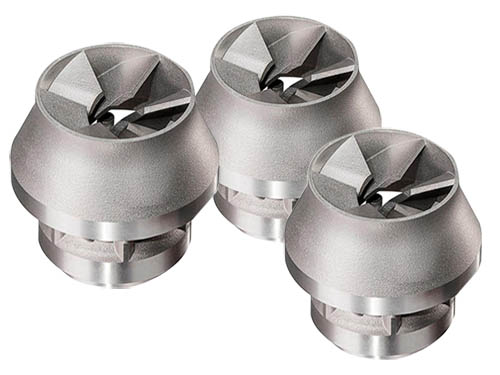
Steel 3D printing parts
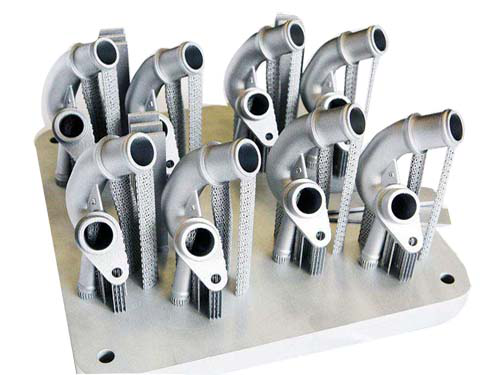
Aluminum 3D printing parts
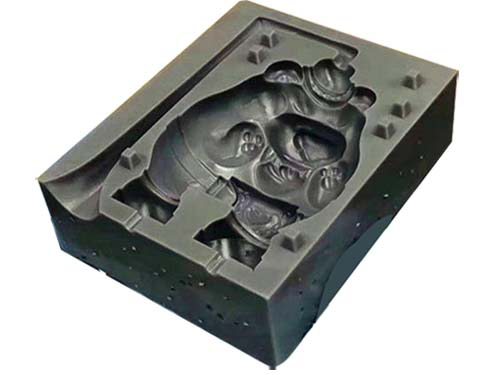
3D printing mold insert
3. Types of metal 3D printing
There are five kinds of metal 3D printing technologies: SLS, SLM, npj, lens and EBSM.
1) . selective laser sintering (SLS)
SLS is composed of a powder cylinder and a forming cylinder. The piston of the powder cylinder rises. The powder is evenly laid on the forming cylinder by the powder paver. The computer controls the two-dimensional scanning track of the laser beam according to the slice model of the prototype. The solid powder material is selectively sintered to form a layer of the part. After the completion of one layer, the working piston drops one layer thickness, the powder spreading system spreads new powder, and controls the laser beam to scan and sinter the new layer. In this way, the cycle is repeated layer by layer until the three-dimensional parts are formed.
2) . selective laser melting (SLM)
The basic principle of laser selective melting technology is to design the three-dimensional solid model of the part by using the three-dimensional modeling software such as Pro / E, UG and CATIA on the computer, then slice the three-dimensional model through the slicing software, get the profile data of each section, generate the filling scanning path from the profile data, and the equipment will control the selective melting of laser beam according to these filling scanning lines Each layer of metal powder material is gradually stacked into three-dimensional metal parts. Before the laser beam starts scanning, the powder spreading device pushes the metal powder onto the base plate of the forming cylinder, and then the laser beam melts the powder on the base plate according to the filling scanning line of the current layer, and processes the current layer, and then the forming cylinder descends a layer thickness distance, the powder cylinder rises a certain thickness distance, the powder spreading device spreads the metal powder on the processed current layer, and the equipment adjusts Enter the data of the next layer contour for processing, and then process layer by layer until the whole part is processed.
3) . nanoparticle spray metal forming (NPJ)
Ordinary 3D printing technology of metal is to use laser to melt or sinter metal powder particles, while npj technology uses not powder shape, but liquid state. These metals are wrapped in a tube in the form of liquid and inserted into a 3D printer, which uses "molten iron" containing metal nanoparticles to spray into shape when 3D printing metal. The advantage is that the metal is printed with molten iron, the whole model will be more mellow, and the ordinary ink-jet printing head can be used as a tool. When the printing is finished, the construction chamber will evaporate the excess liquid by heating, leaving only the metal part
4) . laser near net shaping (lens)
Laser near net shaping (lens) technology uses the principle of laser and powder transport at the same time. The 3D CAD model of the part is sliced by computer, and the 2D plane contour data of the part is obtained. These data are then transformed into the motion track of the NC worktable. At the same time, the metal powder is fed into the laser focus area at a certain feeding speed, melted and solidified rapidly, and then the near net shape parts can be obtained by stacking points, lines and surfaces. The formed parts can be used without or only with a small amount of processing. Lens can realize the mold free manufacturing of metal parts and save a lot of costs.
5) . electron beam melting (EBSM)
Electron beam smelting technology was first developed and used by arcam company in Sweden. Its principle is to use electron gun to shoot high-density energy generated by electron beam after deflection and focus, which makes the scanned metal powder layer generate high temperature in local small area, leading to melting of metal particles. The continuous scanning of electron beam will make the tiny molten metal pools melt and solidify each other, and form the linear and surface metal layer after connection.
Among the above five metal printing technologies, SLS (selective laser sintering) and SLM (selective laser melting) are the mainstream application technologies in metal printing.
4. Application of metal 3D printing
It is often used in mold manufacturing, industrial design and other fields to make models, and then it is gradually used in the direct manufacturing of some products, and then it is gradually used in the direct manufacturing of some products. There are already parts printed by this technology. The technology has applications in jewelry, footwear, industrial design, architecture, engineering and construction (AEC), automotive, aerospace, dental and medical industries, education, geographic information systems, civil engineering, firearms and other fields.
Metal 3D printing, with the advantages of direct molding, no mold, personalized design and complex structure, high efficiency, low consumption and low cost, has been widely used in petrochemical engineering applications, aerospace, automobile manufacturing, injection mold, light metal alloy casting, medical treatment, paper industry, power industry, food processing, jewelry, fashion and other fields.
Metal printing productivity is not high, usually used for the rapid manufacturing of single or small batch parts, without the cost and time of mold opening. Although 3D printing is not suitable for mass production, it can be used for rapid manufacturing of various molds for mass production.
1) . industrial sector
At present, many industrial departments have used metal 3D printers as their daily machines. In prototype manufacturing and model production, 3D printing technology is almost used. At the same time, it can also be used in the production of some large parts
The 3D printer prints out the parts and then assembles them. Compared with the traditional manufacturing process, 3D printing technology can shorten the time and reduce the cost, but also achieve greater production.
2) . medical field
Metal 3D printing is widely used in medical field, especially in dentistry. Unlike other surgeries, metal 3D printing is often used to print dental implants. The biggest advantage of using 3D printing technology is customization. Doctors can design implants according to patients' specific conditions. In this way, the patient's treatment process will reduce the pain, and there will be less trouble after the operation.
3) . jewelry
At present, many jewelry manufacturers are transforming from resin 3D printing and wax mold manufacturing to metal 3D printing. With the continuous improvement of people's living standards, the demand for jewelry is also higher. People no longer like ordinary jewelry in the market, but want to have unique customized jewelry. Therefore, it will be the future development trend of jewelry industry to realize customization without mold, among which metal 3D printing will play a very important role.
4) . Aerospace
Many countries in the world have begun to use metal 3D printing technology to achieve the development of national defense, aerospace and other fields. GE's first 3D printing plant in the world, built in Italy, is responsible for making parts for leap jet engines, which proves the ability of metal 3D printing.
5) . Automotive
The application time of metal 3D printing in automobile industry is not too long, but it has great potential and rapid development. At present, BMW, Audi and other well-known automobile manufacturers are seriously studying how to use metal 3D printing technology to reform production mode
Metal 3D printing is not limited by the complex shape of the parts, directly formed, fast and efficient, and does not need high investment of the mold, which is suitable for modern manufacturing. It will be developed and applied rapidly now and in the future. If you have metal parts that need 3D printing, please contact us.
Metal 3D printing is not limited by the complex shape of the parts, directly formed, fast and efficient, and does not need high investment of the mold, which is suitable for modern manufacturing. It will be developed and applied rapidly now and in the future. If you have metal parts that need 3D printing, please contact us.





